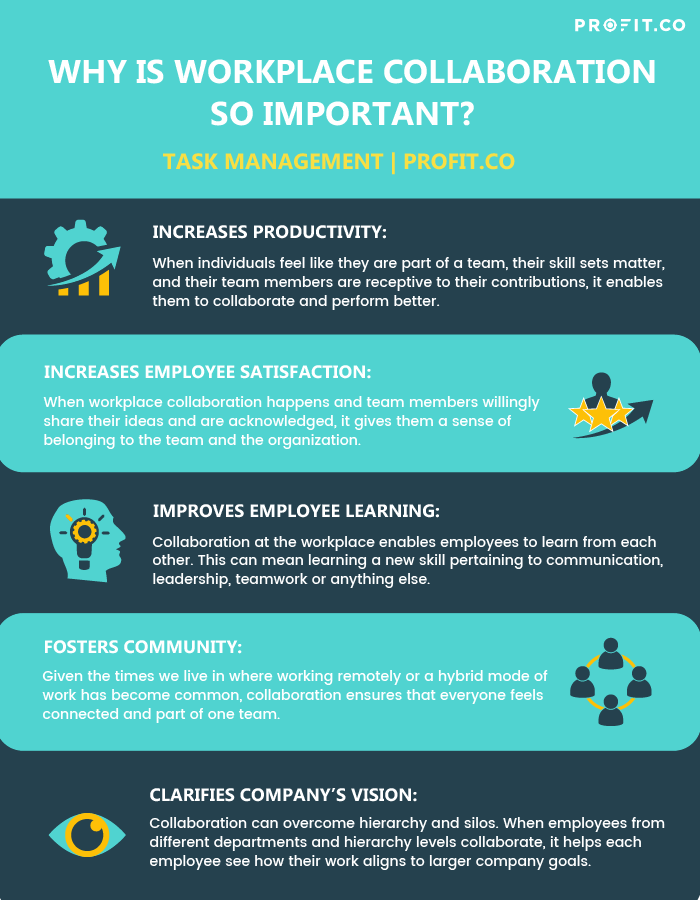What is the definition of Collaboration?
Define collaboration: The process of two or more people or organizations working together to complete a task or achieve a goal or achieve shared goals.
Collaboration is essential for the success of a business and the effectiveness of a workplace. Collaboration can come in many forms, all of which can contribute to higher productivity, growth, and better results.
Great things in business are never done by one person. They’re done by a team of people.
What are the different types of collaboration?
There are a few different kinds of collaboration, and it’s good for an organization to know what those different types are so that they can apply what best works for them.
Let’s look at a few different types of Collaborations:
- Team collaboration
- Contextual collaboration
- Cross-functional collaboration
- Community collaboration
- Social collaboration
- Virtual Collaboration
- Cloud collaboration
1. Team collaboration
In this type of collaboration, people within a team share knowledge or work together. Everyone knows each other. They bring their collective skill sets and contribute towards a common goal. There’s a team leader that makes sure there’s effective communication and collaboration that takes place and everybody gets a fair chance at bringing their strength and skill set toa project. This way, everyone contributes, and all skills and achievements are recognized by peers.
2. Contextual collaboration
Contextual collaboration is when a team works together on a platform where they bring all their digital tools together, in one place, so that everyone in the team can view and access all of the files. The team members shouldn’t have to switch between tools and apps when they collaborate and work on a project together. Having everything in one place, accessible at all times, leads to higher productivity and efficiency.
3. Cross-functional collaboration
Cross-functional collaboration is when teams from across departments within an organization collaborate together to work on a common project; for example, when launching a new product. The product development team can design and present the product, which in turn would inform the implementation team’s work rolling the product out to customers, which affects how the marketing team designs the campaign around these features for the product. This type of collaboration brings the expertise of different departments to one project. Companies that get this right perform better on the innovation scale.
4. Community collaboration
Community collaboration is when individuals with a common interest work together. The idea behind community collaboration is to learn and share knowledge instead of completing a task or a project so that individuals move past silos and hierarchy while sharing knowledge. Community collaboration can be internal or external. If there’s a team member with many years of experience, they can pass on that knowledge to the team. While the goal is not to complete a project, it helps arm the team with the knowledge to help them perform better.
External community collaboration can also come in handy. For example, an SEO manager might be part of a community of SEO professionals. The SEO manager can ask questions to this community about any problems they might be facing and get some direction as to how to resolve them, which they can then bring back to their team.
5. Social collaboration
With social collaboration, team members can collaborate with other team members to arrive at a solution for any problem they might be facing. Social collaboration can be very helpful as it brings together the team’s collective expertise instead of relying on individual skillset. It enables communication with other people in the group to gather advice or to discuss common topics of interest.
6. Virtual Collaboration
The digital landscape has evolved so much over the years and given the current circumstances, virtual collaboration has become the norm for a majority of workers around the world. Virtual collaboration enables individuals to work together even when they are not in the same location. There are so many softwares that exist today that make virtual collaboration as seamless as if everyone were working together in the same location. The chat and video software that exist today have become a part of a normal workplace. Video collaboration can also take travel out of the equation as it may not be necessary to travel for work for a lot of reasons anymore. Of course, the organization has to make sure that they equip their employees with a top-tier digital workplace platform and invest in the right software based on what the organization and its people need. Software can either make or break remote performance for many businesses.
Are you looking for the right platform to collaborate with your team, track quarterly goals, and manage performance, tasks, and much more? Get started with Profit.co free today!
7. Cloud collaboration
Cloud collaboration is another form of virtual collaboration. With cloud collaboration, employees can work on the same documents from different locations. These files update in real time, and all members of the team can access and work on the file at the same time. All members of the team can review the work and leave comments on the document for everyone to see. This enables a much more efficient way of working.
Why is workplace collaboration important?
Workplace collaboration is important for a number of reasons. Here are a few ways in which it can benefit the organization and employees:
- Increases productivity
- Increases employee satisfaction
- Improves employee learning
- Fosters community
- Clarifies company’s vision

1. Increases productivity
When individuals feel like they are part of a team, their skill sets matter, and their team members are receptive to their contributions, it enables them to collaborate and perform better. Collaboration with coworkers can lead employees to feel more valued and accountable for their tasks, resulting in higher productivity and achievement.
2. Increases employee satisfaction
When workplace collaboration happens and team members willingly share their ideas and are acknowledged, it gives them a sense of belonging to the team and the organization. This helps increase employee satisfaction.
3. Improved employee learning
Collaboration at the workplace enables employees to learn from each other. This can mean learning a new skill pertaining to communication, leadership, teamwork or anything else. There’s a lot that individuals can learn from each other, and when collaboration is encouraged, employees can contribute more to their peers and to the company.
4. Enhanced sense of community for remote employees
Given the times we live in where working remotely or a hybrid mode of work has become common, collaboration ensures that everyone feels part of the team, as if they were all working from one location.
5. Heightened understanding of company vision
Collaboration can overcome hierarchy and silos. When employees from different departments and hierarchy levels collaborate, it helps each employee realize how valuable their contribution is to the overall team, and helps them connect their daily work with high-level company goals.
How to create a Collaborative Culture at work
Building a culture of collaboration doesn’t always come easy. Organizations need to deliberately create opportunities for employees on different teams and with skill sets to work together. Organizations that believe in this collaborative culture believe that when employees bring their unique capabilities together to work collectively, everybody and the organization performs better.
That said, there are many ways that organizations strengthen their collaborative culture. Here are a the strategies that can help:
- Sharing knowledge
- Being transparent
- Creating spaces for collaboration
- Providing tools that enable collaboration
- Establish trust
- Communication
- Engagement
1. Sharing knowledge
Sharing knowledge is the number one way that organization can help build on employee skills and encourage collaboration. This can, however, be a challenging initiative. Many top performers may not take the time to share their knowledge and techniques with other team members because they are focused on productivity and achievement.
To make sharing easier for individuals, organizations should outline sharing processes, or set up a learning repository that makes it easy for employees to add a how-to on a difficult process, or send out a memo about how to perform a certain task.
OKRs are a great way to not only achieve goals, but also keep a detailed catalogue of lessons learned.
2. Being transparent
Organizations that foster a culture of transparency are also those that have the strongest cultures of collaboration. Sharing knowledge, information, and news can go a long way in helping teams perform better and more efficiently. Not much good has ever come from working in silos and stopping the flow of information and communication.
3. Creating spaces for collaboration
Organizations that believe in collaboration should create spaces for teams to collaborate. These are like breakout spaces where they can gather and discuss ideas. These rooms or spaces are located in cross-functional locations with rather informal decor and ambience with whiteboards and other tools that are aimed at facilitating free flow of ideas and discussions.
To encourage collaborative spaces during remote work, ensure every employee has a Zoom or Microsoft Teams account and use a platform that encourages collaboration and interaction between employees.
4. Providing tools that enable collaboration
Organizations that encourage collaboration provide their teams with tools that facilitate collaboration, like the right software, the right technology, and the right processes. When teams and individuals know what tools they have available, they can find ways to collaborate and interact with each other on their own terms.
5. Establish trust
Organizations that take collaboration seriously must establish trust. Trying to encourage collaboration in an organization where trust hasn’t been established between employees and management and between co-workers can be a very unsuccessful endeavor. In fact, it might work against the organization. Therefore, it’s very important that team members trust each other and each other’s skillsets before they collaborate with one another.
6. Communication
Just as trust is a key foundation upon which a culture of collaboration is built, so is communication. Teams and individuals need to be able to communicate with each other effectively. When ideas are communicated amongst people of an organization, it’s better for business and makes employees more comfortable with interacting with each other across departments and hierarchies on a regular basis.
7. Create engagement
Employees will be more willing to collaborate with their co-workers if they feel motivated and engaged with their work. High employee engagement fosters a sense of belonging and they feel like their contributions and their opinions matter. This makes employees feel more connected to the organization and to their peers, making them more likely to collaborate within their teams.
What are 3 important skills required for collaboration to happen?
Three essential skills that companies need to have in order to successfully create a collaborative culture are:
- Technological savvy
- The ability to convey the right information
- The attitude and aptitude for collaboration
1. Technological savvy
The current work landscape requires companies to be technologically savvy. The rate at which technology is evolving, it is important to evolve with it.. When companies have technological savvy, they’re able to find ways to easily collaborate, even in the midst of remote work.
2. The ability to convey the right information
Information that’s conveyed to employees should be absolutely clear and correct. There’s no room for ambiguity in the workplace. One misstep or miscommunication can spiral out of control and be a huge setback to the organization’s progress. Therefore, an organization needs to figure out the best way to communicate the right information to its employees.
3. The attitude and aptitude for collaboration
Tools and ambience may not be enough if there isn’t the right mindset for collaboration. For collaboration to be effective, an organization needs to have the right attitude and aptitude to make it happen. It’s always important to keep the team at the center of an organization, and not defer to one executive or leader to call all the shots.
In Conclusion
Humans are naturally social beings, and they are designed to work together. It’s on the organization to encourage this innate quality and bring it to the forefront of workplace culture. The secret to success of an organization is innovation and creativity, and the secret to innovation and creativity lies in collaboration, not in silos. Create spaces and an environment for people to feel safe and appreciated and welcomed, and a collaborative culture will follow.
Want an OKR software that can help you foster a culture of collaboration, innovation, and achievement? Book a free demo with one of Profit.co’s OKR experts today!

